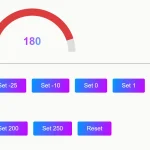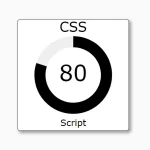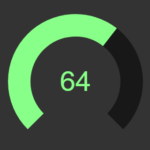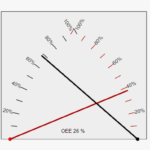| Author: | JohnrBell |
|---|---|
| Views Total: | 72,646 views |
| Official Page: | Go to website |
| Last Update: | March 12, 2015 |
| License: | MIT |
Preview:

Description:
A pure CSS solution to create pretty, fast and responsive bar gauges which can be used for counter, progress bar, or anything else.
How to use it:
Build the Html structure for the gauge.
<div class="container">
<div class="gauge-a"></div>
<div class="gauge-b"></div>
<div class="gauge-c"></div>
<div class="gauge-data">
<h1 id="percent">0%</h1>
</div>
</div>The required CSS styles.
.container {
width: 400px;
height: 200px;
position: absolute;
top: 30%;
left: 50%;
overflow: hidden;
text-align: center;
transform: translate(-50%, -50%);
}
.gauge-a {
z-index: 1;
position: absolute;
background-color: rgba(255,255,255,.2);
width: 400px;
height: 200px;
top: 0%;
border-radius: 250px 250px 0px 0px;
}
.gauge-b {
z-index: 3;
position: absolute;
background-color: #222;
width: 250px;
height: 125px;
top: 75px;
margin-left: 75px;
margin-right: auto;
border-radius: 250px 250px 0px 0px;
}
.gauge-c {
z-index: 2;
position: absolute;
background-color: #5664F9;
width: 400px;
height: 200px;
top: 200px;
margin-left: auto;
margin-right: auto;
border-radius: 0px 0px 200px 200px;
transform-origin: center top;
transition: all 1.3s ease-in-out;
}
.container:hover .gauge-c { transform:rotate(.5turn);
}
.container:hover .gauge-data { color: rgba(255,255,255,1); }
.gauge-data {
z-index: 4;
color: rgba(255,255,255,.2);
font-size: 1.5em;
line-height: 25px;
position: absolute;
width: 400px;
height: 200px;
top: 90px;
margin-left: auto;
margin-right: auto;
transition: all 1s ease-out;
}










i have made a a more adaptable code :) try it ;)
.gauge {
width: 56px;
height: 28px;
position: relative;
text-align: center;
margin: auto;
overflow: hidden;
}
.gauge-back {
/* z-index: 1; */
/* position: absolute; */
background-color: rgba(240,240,240,.8);
width: 100%;
height: 100%;
/* top: 0%; */
border-radius: 250px 250px 0px 0px;
}
.gauge-b {
z-index: 3;
position: absolute;
background-color: red;
width: 75%;
height: 75%;
/* top: 50%; */
bottom: 0;
margin-left: 50%;
transform: translateX(-50%);
margin-right: auto;
border-radius: 250px 250px 0px 0px;
}
.gauge-level {
z-index: 2;
position: absolute;
background-color: #00E676;
width: 100%;
height: 100%;
/* top: 200px; */
margin-left: auto;
margin-right: auto;
border-radius: 0px 0px 200px 200px;
transform-origin: center top;
transform: rotate(180deg);
}
.gauge-data {
z-index: 4;
color: #FFF;
font-size: 1.5em;
line-height: 25px;
position: absolute;
width: 100%;
height: 100%;
top: 50%;
margin-left: auto;
margin-right: auto;
}
///////////////////
0%
Hello,
I want to display the gauge on à kiosk (no user interaction).
The value will be set by server here 20%
Thanks